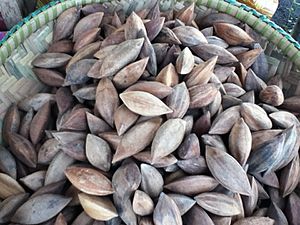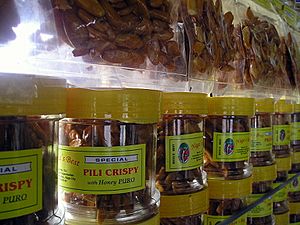Pili facts for kids
Quick facts for kids Pili |
|
|---|---|
 |
|
| Unshelled pili nuts from the Philippines | |
| Conservation status | |
| Scientific classification | |
| Genus: |
Canarium
|
| Species: |
ovatum
|
| Nutritional value per 100 g (3.5 oz) | |
|---|---|
| Energy | 3,008 kJ (719 kcal) |
|
3.98 g
|
|
|
79.55 g
|
|
| Saturated | 31.184 g |
| Monounsaturated | 37.229 g |
| Polyunsaturated | 7.605 g |
|
Protein
|
10.80 g
|
| Tryptophan | 0.189 g |
| Threonine | 0.407 g |
| Isoleucine | 0.483 g |
| Leucine | 0.890 g |
| Lysine | 0.369 g |
| Methionine | 0.395 g |
| Cystine | 0.189 g |
| Phenylalanine | 0.497 g |
| Tyrosine | 0.381 g |
| Valine | 0.701 g |
| Arginine | 1.516 g |
| Histidine | 0.255 g |
| Alanine | 0.509 g |
| Aspartic acid | 1.222 g |
| Glutamic acid | 2.393 g |
| Glycine | 0.650 g |
| Proline | 0.471 g |
| Serine | 0.599 g |
| Vitamins | Quantity
%DV†
|
| Vitamin A equiv. |
0%
2 μg |
| Thiamine (B1) |
79%
0.913 mg |
| Riboflavin (B2) |
8%
0.093 mg |
| Niacin (B3) |
3%
0.519 mg |
| Vitamin B6 |
37%
0.479 mg |
| Folate (B9) |
15%
60 μg |
| Vitamin B12 |
0%
0.00 μg |
| Vitamin C |
1%
0.6 mg |
| Minerals | Quantity
%DV†
|
| Calcium |
15%
145 mg |
| Copper |
48%
0.958 mg |
| Iron |
27%
3.53 mg |
| Magnesium |
85%
302 mg |
| Manganese |
110%
2.313 mg |
| Phosphorus |
82%
575 mg |
| Potassium |
17%
507 mg |
| Sodium |
0%
3 mg |
| Zinc |
31%
2.97 mg |
| Other constituents | Quantity |
| Water | 2.77 g |
|
Link to USDA Database entry
|
|
| †Percentages estimated using US recommendations for adults. | |
The Pili tree (scientific name: Canarium ovatum) is a special kind of tropical tree. It belongs to a group of trees called Canarium. There are about 600 different types of trees in its family, called Burseraceae.
Pili trees are originally from the Philippines. People there grow them for their tasty nuts. The Pili nut is a very important crop in the Philippines. Sometimes, people call the Pili tree by a general name like "Java almond." But this name can be confusing because it refers to many different trees in the Canarium group.
Contents
About the Pili Tree
The Pili tree is an evergreen tree, meaning it stays green all year. It usually grows to about 20 meters (65 feet) tall. Its wood has a sticky sap, and the tree can stand strong winds.
Pili trees are "dioecious," which means there are separate male and female trees. The flowers grow in clusters where the leaves meet the stem. Some Pili trees can have both male and female parts on the same tree. Insects help to pollinate the flowers. The trees flower often, and their fruits ripen over a long time.
The Pili Fruit
The Pili fruit is a type of fruit called a drupe. This means it has a fleshy outer part and a hard shell inside, like a peach or an olive. The fruit is usually 4 to 7 centimeters (1.5 to 2.7 inches) long. It weighs between 15.7 and 45.7 grams (0.5 to 1.6 ounces).
When the fruit ripens, its skin turns purplish-black. The middle part, or pulp, is green-yellow and has fibers. Inside the hard shell is the edible nut. This nut has two main parts, called cotyledons. These cotyledons make up most of the nut's weight. They are rich in fat (about 70%), protein (11.5 to 13.9%), and carbohydrates (about 8%). Some nuts might taste bitter or have a smell like turpentine.
Where Pili Trees Grow
Pili trees are mostly found in the Philippines. They are tropical trees that like deep, rich soil and warm weather. They also need plenty of rain spread throughout the year.
Pili trees cannot handle cold temperatures or frost at all. Their seeds are also tricky to store. If kept in a refrigerator, they lose their ability to grow after just five days. Seeds stored at room temperature for a few months also become much less likely to sprout.
Growing Pili Trees
It has been hard to grow new Pili trees from cuttings or by grafting (joining parts of two plants). This is because the methods have not always worked well. However, farmers are still working on better ways to grow more Pili trees.
A mature Pili tree can produce about 100 to 150 kilograms (220 to 330 pounds) of nuts in their shells each year. The main harvest season is from May to October, with the most nuts picked between June and August. The quality of nuts can be very different from tree to tree if they are grown from seeds.
When Pili nuts are fresh, the kernel often sticks to the shell. But after drying them for about a day, the kernel comes out easily. Shelled nuts can be stored for up to a year without losing their quality.
Uses of the Pili Nut
In the Philippines, the main places where Pili nuts are grown are the Bicol Region, especially in the provinces of Sorsogon, Albay, and Camarines Sur. Most Pili nuts are collected from wild trees in the mountains, not from large farms. In 1977, the Philippines sent about 3.8 tons of Pili products to Guam and Australia.
Edible Parts and Products
Both the young shoots and the fruit pulp of the Pili tree can be eaten. The shoots are used in salads. The pulp is often boiled and seasoned. Boiled Pili pulp feels a bit like a sweet potato and is oily, similar to an avocado. The oil from the pulp can be used for cooking or to make soap.
The hard shells of the nuts are also useful. They make great fuel for fires. They can also be used as a growing material for orchids and anthurium plants. The tree's sap can even be used to help start fires, like gasoline.
The most important part of the Pili tree is its kernel (the nut inside the shell). When raw, it tastes a bit like roasted pumpkin seed. When roasted, it has a nutty flavor and a waxy feel, similar to a pine nut. High-quality Pili nuts are large, round, and have a thin shell and pulp. The kernel should be white and rich in protein and oils, with a mild nutty taste.
In the Philippines, Pili nuts are used to make delicious candies and brittle.
The "Java Almond" Connection

The name "Java almond" is often used for Pili nuts. However, this name can also refer to nuts from other Canarium species. These include Canarium vulgare and Canarium indicum, which are not grown in the Philippines. The name "Java almond" is a general term for nuts from Canarium trees found in places like maritime Southeast Asia, Papua New Guinea, and Northern Australia.
Pili trees are grown as ornamental trees in many tropical areas. But Indonesia and the Philippines are the main countries that harvest and use them for business. People in the Philippines are thought to be the first to cook the Pili fruit pulp to make it edible. Pili nuts are also sold in the United States.
In Indonesia and Malaysia, their "Java almond" is called kenari. This comes from the Canarium vulgare and C. indicum trees. In Indonesia, especially in the Minahasa and Moluccas, the kernels are used to make cakes. Java almond kernels are also used in chocolate, ice cream, and baked goods. Large amounts of Pili nuts are bought by Hong Kong and Taiwan. The kernel is a key ingredient in a famous Chinese dessert called "moon cake."
The kernel of the Java almond is about 70% fat, 11.5-13.9% protein, and 8% carbohydrates. The oil from the kernel is mostly made of oleic acid, palmitic acid, linoleic acid, and stearic acid. The nuts are rich in minerals like potassium, phosphorus, magnesium, and calcium.
Pili Tree Reproduction and Growth
Pili nut trees can be grown in several ways. They can be grown from seeds, or from parts of an existing tree. Growing from seeds takes about 30 to 80 days for the seed to sprout. After about three to four years, the young tree can reach a height of about 2 meters (6.5 feet).
Trees grown from seeds usually start producing fruit after 5 to 6 years. They reach their best production around their 10th year. While growing from seeds is common, growing from parts of a tree is becoming more popular. This method helps ensure more female plants, makes trees produce fruit faster, and keeps the trees genetically similar.
Growing from Cuttings
Methods like marcotting and air layering are simple ways to grow new Pili trees from branches. However, these methods don't always work perfectly. Sometimes the branch doesn't grow roots after being cut from the main tree.
For commercial growing in the Philippines, a method called cleft or wedge grafting is used. This involves joining a small branch from a Pili tree onto the root system of another plant. This is done between November and February when the weather is cool and dry. This method has a high success rate of about 85%. Another method, patch budding, is very good for growing many trees at once, with a success rate of 75 to 80%.
Future of Pili Cultivation
One challenge for Pili nut production is how hard it is to grow new trees reliably. Without an easy way to clone the best trees, it's difficult to collect and test the best types of Pili. Scientists are working to create Pili trees that are better for commercial farming.
The National Clonal Germplasm Repository in Hawaii, part of the USDA, is studying ways to grow and preserve Pili trees. A new Pili nut tree type in Hawaii, called 'Poamoho', might help increase interest in this crop. Its nuts are special because the kernels easily separate from the shell without needing to be dried first.
See also
 In Spanish: Canarium ovatum para niños
In Spanish: Canarium ovatum para niños



